Header logo
header top contact widget
Dental Implants
Understanding Dental Implants
Posted on Oct 17, 2016 by William J. Claiborne, DDS MS
Although dental implants are nothing new to the dental field, there is still a bit of confusion as to their makeup. This is likely because dental implants come in a wide variety of shapes and sizes, each to accommodate specific needs.
For example, some implant systems are designed to support non-removable teeth while others may support teeth that are detachable for cleaning. Some implants support one or several teeth while others are designed for placement in minimum bone mass.
While dental implants have one of the highest of all implant-in-bone success rates (including that of knees and hip joints), having a successful outcome can greatly depend on having the proper implant selected for you. This can occur when you rely on an experienced dental specialist who is trained in the diagnosis and placement of all types.
To help clear up confusion about how implants work, it is important to understand the components. Below is an explanation of what dental implants are and how they work.
• Dental Implants are actually replacements for tooth roots. The implanted portion is placed in your jaw bone where a tooth root was once held.
• The ‘implant’ is not the tooth. It will help to hold the tooth (referred to as the ‘restoration’) but its primary function is to serve as the anchor for an attached tooth, or a replacement tooth root. By being placed in the jaw bone, just as a natural tooth root, the implant can support the attached tooth with a firm foundation for optimal stability.
• The implant becomes anchored in the jaw bone through a process known as ‘osseo-integration.’ The word ‘osseo’ refers to bone, and the integration process is like a rope tied around a tree branch. In time, the branch grows around the rope. Osseo-integration is like this but occurs at a much more rapid pace.
• Once the implant has become secured by the bone, a post is inserted into the hollow center of the implant. The replacement tooth (or teeth) is attached to this post. You new tooth looks, feels and functions like the natural tooth once positioned there.
• An implant is not always necessary for each missing tooth. In some instances, one implant can hold two or a bridge of teeth. Several strategically-placed implants can also support a full arch of teeth in many cases.
Regardless of the type of implant placed, it is important to remember that implants do occasionally fail. This can be due to clenching or grinding teeth. Smoking complicates and delays the healing process and can also contribute to implant failure. If infection sets in and reaches the implanted portion, the implant may need to be removed so the treatment can resolve the problem.
A major benefit of dental implants is their lifespan. Implants are designed to last your lifetime. Too, dental implants do not decay, will never need a root canal and do not rely on support from neighboring teeth. The best thing, however, is that dental implants restore your ability to eat with stability, chew comfortably, laugh with confidence and speak without worry.
There are many types of implants, each designed to accommodate specific needs. As a Periodontist, I bring extensive and specialized training in the diagnosis and placement of the implant that will work best for you.
Call 828-274-9440 to arrange a consultation. During this time, we’ll discuss the implant types that are best suited for your needs and goals as well as the process and anticipated costs.
Five Easy Steps To Save Time & Money At The Dentist
Posted on Oct 03, 2016 by William J. Claiborne, DDS MS
The reason we change the filters in our home’s air vents is to keep our HVAC system operating efficiently and to avoid expensive repairs.
The reason we have our car’s oil changed on a regular basis is to ensure proper operation and to avoid major problems.
The reason we clean and bandage a cut is to prevent an infection from occurring, which could require the involvement of a doctor and prescription medications.
So, doesn’t it make perfect sense to spend just minutes each day to prevent dental problems from occurring that can be costly and time-consuming to repair?
Your oral health goes far beyond a confident smile. Over the years, extensive research has linked the bacteria of periodontal (gum) disease to heart attacks, stroke, high blood pressure, arthritis, diabetes, preterm babies and impotency.
Symptoms of periodontal disease include seeing blood while brushing, frequent bad breath, tender gums, gums that pull away from teeth and gum tissue that darkens from a healthy pink to red.
Oral bacteria can cause major destruction to teeth and gums, including tooth roots beneath the gum line. Once gum disease begins, it will only worsen without treatment. However, avoiding cavities and gum disease is nothing complicated. Quite frankly, it’s easy with a commitment to a thorough at-home regimen and regular dental check-ups.
Steps to help you avoid dental expenses include:
1). Brush twice a day for a minimum of two minutes using a soft bristle tooth brush and tooth paste with fluoride. At the end of brushing, brush your tongue to dislodge oral bacteria that are embedded there.
2). Flossing can have a tremendous effect on controlling oral bacteria. Our hygienist can help you with your technique or you may wish to purchase an electronic flosser.
3). Drink plenty of water during the day and minimize colas, tea, coffee and energy drinks. These beverages contain high levels of caffeine, which has a drying affect on oral tissues. Also drying is smoking, which contains a lengthy list of toxic chemicals that are readily absorbed by moist gum tissues.
4). When eating citrus or acidic foods (including tomatoes, orange juice, wine and foods with vinegar), remember that these highly-acidic foods will mix with a digestive acid that’s produced in the mouth. This double-whammy of acid can soften tooth enamel for 20 – 30 minutes. Because brushing your teeth right after consuming these foods can wear down tooth enamel, wait 30 minutes after eating to brush. Rather, swish with water or chew sugarless gum during this time.
5). Sugar and carbohydrates give a super-boost to the reproduction of oral bacteria. Try to limit these foods and sugar-laden drinks to protect your smile and your waistline!
In addition to a thorough at-home routine, be committed to your 6-month exams and cleanings. These visits rid your smile of build-up that has occurred since your last appointment and catches problems while they are easy to treat.
Keep your money in your pocket by avoiding cavity repair and treatment for gum disease. Your smile AND your wallet will thank you!
Call 828-274-9440 for an appointment if you are experiencing any of the symptoms mentioned above.
Taking Prescriptions? Some Supplements Can Cause Problems.
Posted on Sep 27, 2016 by William J. Claiborne, DDS MS
As baby boomers age, a growing number are turning to alternatives to prescription medications. Thus, there has been a growing demand for natural supplements. It is estimated that over 15 million Americans are using vitamins and herbal supplements along with prescription medications.
Surveys estimates show that herbal supplements are used by 12 – 24% of the American adult population with usage of those aged 65 and older doubling from 1999 to 2002.
Since supplements are available over the counter (OTC), many adults don’t see them as medications. So, when a new patient is completing their medical history form, these are not always listed. They should be.
Both medical and dental health care providers need this information to determine how these supplements will effect your body’s ability to clot properly during procedures that cause bleeding. Too, excessive bleeding can occur when these supplements are not acknowledged prior to procedures.
A number of aging adults take prescription medications to prevent arterial or venous thrombosis and stroke. When completing your medical history form, most patients readily acknowledge their use of these medications and understand that some drugs increase bleeding during certain procedures or hamper their ability to clot when bleeding. Knowing the patient is on these medications enables the medical or dental caregiver to monitor bleeding and clotting before complications arise. 
However, patients are less informed that the use of OTC medications can impact bleeding in conjunction with their prescription medications. Yet, according to the Natural Medicines Comprehensive Database, approximately 180 dietary supplements have the potential to interact with warfarin and more than 120 may interact with aspirin, such as clopidogrel (Plavix) and dipyridamole (Aggrenox).
The National Institutes of Health (NIH) identified these supplements as having the potential to cause adverse bleeding interactions:
• Anise
• Dong Quai
• Omega-3 fatty acids in fish oil
• Ajoene in Garlic
• Ginger
• Ginkgo
• Vitamin E
• Fucus
• Danshen
• St. John’s Wort
• American Ginseng
The Centers for Disease Control and Prevention (CDC) shows the supplements having the highest sales include ginseng, ginkgo blob, garlic, St John’s wort and ginger. It is not unusual for a patient to take up to seven dietary supplements at the same time with some taken inconsistently.
In addition, the following herbs may affect blood clotting:
• High doses of Vitamin E
• Alfalfa
• Coenzyme Q10
While more studies are needed to determine precisely how these supplements alter bleeding or interact with prescription medications, it is important for medical and dental professionals to have consumption information in order to properly plan for procedures.
Warfarin (Coumadin®, Jantoven™), an oral anticoagulant, is used prevent and treatment VTE (venous thrombo-embolism), PE (pulmonary embolism), and atrial fibrillation (A-Fib) patients who are at risk of embolism. Warfarin is highly affected by medication use. In fact, more food and drug interactions have been reported for warfarin than with any other prescription medication.
A study in England noted a high number of patients were taking herbal supplements along with warfarin. In a survey of nearly 1400 patients, it was found that nearly 9% regularly took one or more of garlic, ginseng, ginkgo biloba, feverfew, ginger, and St. John’s
wort. Yet, nearly all admitted to failing to share this information with any of their health care professionals.
In addition to many herbal supplements, alcohol has been found to increase bleeding in warfarin users along with Vitamin C and Cranberry juice. However, the herbal supplements that tend to complicate clotting ability the most during bleeding include:
• Bromelain
• Cat’s claw
• Dong quai
• Evening primrose
• Feverfew
• Garlic
• Green tea
• Ginseng
• Ginkgo
• Horse chestnut
• Red clover
In addition to Aspirin’s ability to reduce mild to moderate pain, inflammation, and fever, it is also used in the prevention of myocardial infarction (MI) and cardiovascular problems, such as stroke. Aspirin may also be advised as added therapy during procedures like coronary bypass. While many users of Aspirin realize it “thins the blood,” many regular users fail to notify their dental professional.
As a periodontist, I perform a number of procedures that cause bleeding to tissues in the mouth. It is important for your safety and a successful outcome of your procedure to have this information prior to treatment planning.
While filling out those often-lengthy medical history forms seem daunting, the information they provide is necessary. It is also necessary that it be complete. Herbal and vitamin supplements taken regularly should always be listed.
If you have questions, please call 828-274-9440.
Use HSA Funds Or Insurance Benefits Before End Of Year
Posted on Sep 22, 2016 by William J. Claiborne, DDS MS
As we’re staring October in the face, we realize that the end of 2016 is right around the corner. This typically prompts many of us to assess that list of things we wanted (or needed) to accomplish during the year. If you’re like me, there are a few things still hanging.
Each year, we begin with a number of goals. Now, we must face reality as to what we accomplished. Did we have our annual physical? Did we stick to our exercise/weight loss plan? Did we add to our retirement plan? And so on.
With three months to go in the year, this is no time to panic, but to act. However, as a periodontal specialist, I want to be sure your list includes a couple of items, whether you began the year with them or not. As you look at unused insurance benefits or available HSA funds, this is an excellent time to tend to 2016 goals.
First, did you have an Oral Cancer screening? If you had your 6-month dental check-ups and cleanings, that was likely a part of one of the visits. It’s wise to be certain, however. If you’re not sure, call your dental office and ask.
Did you stick to your daily brushing and flossing commitment? You can prevent much in the way of costs and treatment time by avoiding dental problems in the first place. Twice daily brushing (at least two minutes per time) and daily flossing is an excellent way to keep oral bacteria levels under control. Go further by u sing a tongue scraper each day. Or, brush your tongue at the end of brushing your teeth. This removes an enormous amount of oral bacteria that has taken up residence in your tongue.
sing a tongue scraper each day. Or, brush your tongue at the end of brushing your teeth. This removes an enormous amount of oral bacteria that has taken up residence in your tongue.
Did you accomplish dental repairs to prevent tooth loss? Although I don’t place crowns, I see patients occasionally who have unfortunately lost a tooth because they postponed having one crowned. When your dentist finds cracks or fractures in teeth, he or she may advise having the tooth crowned. This is also the advice for teeth that are overloaded with fillings. If the tooth breaks below the gum line, it requires removal in most cases. Losing a natural tooth leaves you with a new list of expenses and treatment time. A crown can help you avoid this.
Did you achieve the smiling confidence you wanted? For people who wear dentures or partials, the associated discomfort and instability while chewing can be miserable. Dental Implants can solve these problems, restoring a dependable, secure bite. And, because Dental Implants are designed to last a lifetime, they are a wise investment. Begin with a consultation to discuss your best options.
Do you feel good about the appearance of your smile? People who smile often not only appear happier, they are. Research has shown that smiling releases brain chemicals called endorphins. These give us a happiness boost. And, it has also been found that people who smile often live, on average, ten years longer than frequent frowners (who actually decrease their lifespans by a year, on average).
Your smile is not only a part of your facial appearance, it complements your personality and supports your overall health and well-being. Be as dedicated to a healthy smile as you are having a healthy body because, when it comes right down to it, a healthy smile and a healthy body are meant to work as one.
Recent Posts
Categories
Archives
- September 2024
- August 2024
- July 2024
- June 2024
- May 2024
- April 2024
- March 2024
- February 2024
- January 2024
- December 2023
- November 2023
- October 2023
- September 2023
- August 2023
- July 2023
- June 2023
- May 2023
- April 2023
- March 2023
- February 2023
- January 2023
- December 2022
- November 2022
- October 2022
- September 2022
- August 2022
- July 2022
- June 2022
- May 2022
- April 2022
- March 2022
- February 2022
- January 2022
- December 2021
- November 2021
- October 2021
- September 2021
- August 2021
- July 2021
- June 2021
- May 2021
- April 2021
- March 2021
- February 2021
- January 2021
- December 2020
- November 2020
- October 2020
- September 2020
- August 2020
- July 2020
- June 2020
- May 2020
- April 2020
- March 2020
- February 2020
- January 2020
- December 2019
- November 2019
- October 2019
- September 2019
- August 2019
- July 2019
- June 2019
- May 2019
- April 2019
- March 2019
- February 2019
- January 2019
- December 2018
- November 2018
- October 2018
- September 2018
- August 2018
- July 2018
- June 2018
- May 2018
- April 2018
- March 2018
- February 2018
- January 2018
- December 2017
- November 2017
- October 2017
- September 2017
- August 2017
- July 2017
- June 2017
- May 2017
- April 2017
- March 2017
- February 2017
- January 2017
- December 2016
- November 2016
- October 2016
- September 2016
- August 2016
- July 2016
- June 2016
- May 2016
- April 2016
- March 2016
- February 2016
- January 2016
- December 2015
- November 2015
- October 2015
- September 2015
- August 2015
- July 2015
- June 2015
- May 2015
- April 2015
- March 2015
- February 2015
- January 2015
- December 2014
- November 2014
- October 2014
- September 2014
- August 2014
- July 2014
- June 2014
- May 2014
- April 2014
- March 2014
- February 2014
- January 2014
- December 2013
- November 2013
- October 2013
- September 2013
- August 2013
- July 2013
- June 2013
- May 2013
- April 2013
- March 2013
- February 2013
- January 2013
- December 2012
- November 2012
- October 2012
- September 2012
- August 2012
- July 2012
- June 2012


